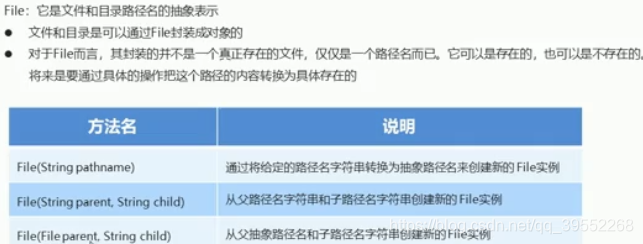java File类的相关操作
本文共 527 字,大约阅读时间需要 1 分钟。
1.File类概述和构造方法
windows系统
- 一个点表示当前目录 直接写文件名字也是如此
- 两个点表示上级目录

注意第三个构造方法 父为对象 子为路径名

直接输出File对象会输出文件的绝对路径因为File类改写了toString()方法,输出时会自动调用
这三个构造方法做了同样的事情
2.File类的创建方法


f4.mkdir()会创建一个名字为javase.txt的文件 如果这时再调用 f4.createNewFile会报false因为已经存在一个名字为javase.txt的目录,在这里目录就是文件的意思 mkdirs只能创建多层目录,如果想创建多层目录+txt文件就用mkdirs+creatNewFile

3.绝对路径和相对路径

4.delete和实例

如果一个文件下有内容,则不能直接删除此文件
5.File常用方法
 、
、

//抽象路径名 绝对路径名和 规范路径名的区别
file.list获取当前文件下的目录或文件的名字
就等于f2.listFiles()方法获取当前目录下所有文件和目录对象后在分别调用他们的getName()方法,但这个方法的好处就是可以通过文件对象来进行各种额外的判断操作如上面展示的
递归遍历一个目录下的所有文件

转载地址:http://ymsi.baihongyu.com/
你可能感兴趣的文章
vue3+Element-plus icon图标无法显示的问题(已解决)
查看>>
NodeJS实现跨域的方法( 4种 )
查看>>
nodejs封装http请求
查看>>
nodejs常用组件
查看>>
nodejs开发公众号报错 40164,白名单配置找不到,竟然是这个原因
查看>>
Nodejs异步回调的处理方法总结
查看>>
NodeJS报错 Fatal error: ENOSPC: System limit for number of file watchers reached, watch ‘...path...‘
查看>>
nodejs支持ssi实现include shtml页面
查看>>
Nodejs教程09:实现一个带接口请求的简单服务器
查看>>
nodejs服务端实现post请求
查看>>
nodejs框架,原理,组件,核心,跟npm和vue的关系
查看>>
Nodejs概览: 思维导图、核心技术、应用场景
查看>>
nodejs模块——fs模块
查看>>
Nodejs模块、自定义模块、CommonJs的概念和使用
查看>>
nodejs生成多层目录和生成文件的通用方法
查看>>
nodejs端口被占用原因及解决方案
查看>>
Nodejs简介以及Windows上安装Nodejs
查看>>
nodejs系列之express
查看>>
nodejs系列之Koa2
查看>>
Nodejs连接mysql
查看>>